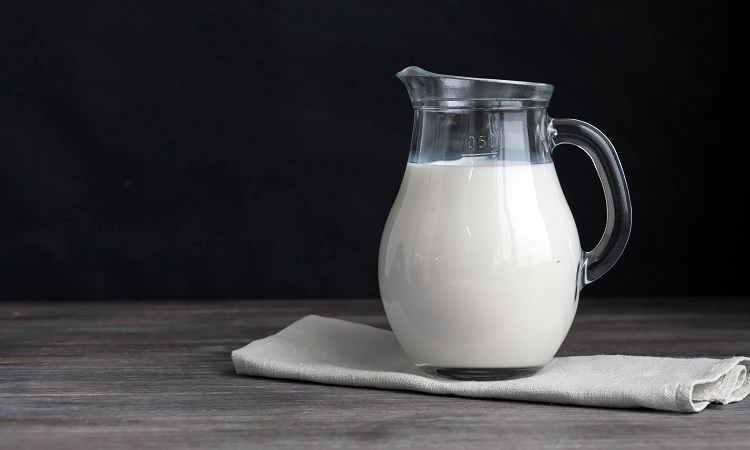Milk is one of the most common drinks in homes around the world. It’s not just tasty and refreshing—it’s full of important nutrients your body needs to grow strong and stay healthy. Whether you enjoy it cold, warm, or mixed in coffee, milk is a big part of many diets. In this article, we will explore what milk is, its benefits, types, and how to include it in your daily life.
Table of Contents
What Is Milk?
Milk is a white liquid made by female mammals to feed their young. The most common type we drink comes from cows. However, milk also comes from goats, sheep, and even plants like almonds, soybeans, oats, and coconuts.
How Is Milk Made?
Cow’s milk is collected on farms using machines that gently pull the milk from cows. After it’s collected, the milk goes through a process called pasteurization, which kills bacteria to make it safe to drink. It is then cooled, packed, and sent to stores.
Health Benefits of Drinking Milk
Milk is known as a “complete food” because it has many of the key nutrients your body needs.
Strong Bones and Teeth
Milk is rich in calcium and vitamin D, which help build strong bones and teeth. This is especially important for children, teens, and older adults.
Muscle Growth and Repair
Milk has high-quality protein that helps build and repair muscles. Athletes often drink milk after workouts to recover faster.
Healthy Heart
Milk contains potassium, which helps keep your blood pressure in check. It also has magnesium, which supports heart health.
Weight Management
Studies show that people who drink milk often feel full longer, which helps control hunger and can prevent overeating.
Types of Milk
There are many different kinds of milk to choose from, depending on your taste, health needs, or diet.
Animal-Based Milk
Whole Milk
Whole milk has the most fat. It is creamy and great for children who need extra calories.
Low-Fat Milk (2% or 1%)
This milk has less fat than whole milk but still provides the same amount of protein and calcium.
Skim Milk (Fat-Free)
Skim milk has all the nutrients of whole milk, but the fat is removed. It’s a good choice if you’re trying to cut calories.
Goat Milk
Goat milk is easier to digest for some people. It has a slightly different taste and is rich in calcium and protein.
Plant-Based Milk
If you are lactose intolerant or vegan, you can drink milk made from plants.
Almond Milk
Almond milk is low in calories and has a light, nutty flavor. It often comes with added calcium and vitamins.
Soy Milk
Soy milk is high in protein and closest to cow’s milk in terms of nutrition.
Oat Milk
Oat milk is creamy and sweet. It’s great in coffee and is often chosen by people with allergies.
Coconut Milk
Coconut milk has a rich, tropical flavor and is good for cooking and baking.
Who Should Drink Milk?
Children
Milk helps children grow strong bones and teeth. It also gives them energy and helps build muscles.
Teenagers
During the teenage years, bones grow fast. Calcium and protein from milk support this growth.
Adults
Milk keeps bones healthy and helps muscles recover after activity.
Seniors
As we age, bones can become weak. Drinking milk helps keep bones strong and lowers the risk of bone diseases like osteoporosis.
How Much Milk Should You Drink?

Health experts suggest:
- Children (2–8 years): 2 cups a day
- Teens and Adults: 3 cups a day
- Older Adults: 3 cups a day
You can drink milk on its own, pour it over cereal, or use it in cooking and baking.
Milk in Daily Life
Milk is not just for drinking. It’s used in many foods and recipes.
Milk Products
Cheese
Cheese is made by curdling milk. It’s full of protein and calcium and comes in many types like cheddar, mozzarella, and feta.
Yogurt
Yogurt is made by fermenting milk with bacteria. It’s good for your gut and can be eaten with fruits or in smoothies.
Butter
Butter is made by churning cream from milk. It’s often used in cooking or as a spread.
Ice Cream
Made with milk, cream, and sugar, ice cream is a delicious dessert enjoyed worldwide.
Common Questions About Milk
Is Milk Safe for Everyone?
Most people can enjoy milk without problems. However, some people have issues with it:
Lactose Intolerance
Some people can’t digest lactose, the sugar in milk. They may feel bloated or have stomach pain. Lactose-free milk or plant-based milk is a good option for them.
Milk Allergy
A milk allergy is more serious than lactose intolerance. It’s more common in children and can cause swelling, itching, or trouble breathing. These people must avoid all dairy products.
How to Add More Milk to Your Diet
Here are easy ways to enjoy more milk:
- Add it to your morning cereal or oatmeal
- Make smoothies with milk, fruits, and yogurt
- Use milk instead of water in pancake or cake recipes
- Drink chocolate milk as a treat after exercise
- Use milk in soups, sauces, or mashed potatoes
Fun Facts About Milk
- Milk has been part of the human diet for over 7,000 years.
- The average cow makes about 6 to 7 gallons of milk each day.
- There are over 270 million dairy cows worldwide.
- Chocolate milk was first made in Jamaica in the early 1700s.
Choosing the Right Milk for You
When picking milk, think about your needs:
- If you want fewer calories: Try skim milk or almond milk
- If you need more protein: Soy milk or cow’s milk is a great choice
- If you want something creamy and rich: Go for whole milk or oat milk
- If you are allergic to dairy: Choose plant-based options like rice or coconut milk
Also, check the labels! Some plant-based milks have added sugars. Go for “unsweetened” versions if you want to stay healthy.
The Environmental Side of Milk
Milk production affects the environment, especially cow’s milk, which needs a lot of water and land. If you’re concerned about the planet, you can:
- Choose local milk to reduce travel pollution
- Support farms that treat animals well
- Try plant-based milks with a lower carbon footprint
Final Thoughts
Milk is a powerful drink that gives your body many key nutrients like calcium, protein, and vitamins. Whether you drink it from a cow, goat, or a plant, milk can be a healthy part of your everyday life. From children to adults, it helps us stay strong, grow, and feel good.
With so many types available, there’s a milk out there for everyone. Just pick the one that fits your taste and health needs—and enjoy the goodness in every sip.










